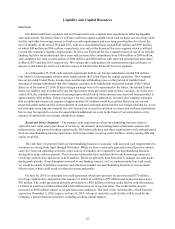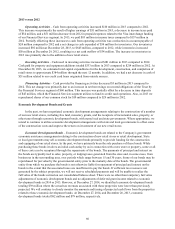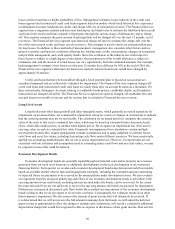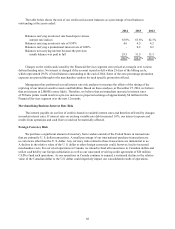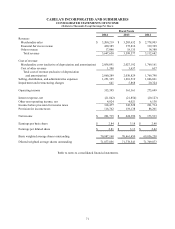Cabela's 2014 Annual Report Download - page 71
Download and view the complete annual report
Please find page 71 of the 2014 Cabela's annual report below. You can navigate through the pages in the report by either clicking on the pages listed below, or by using the keyword search tool below to find specific information within the annual report.61
On a quarterly basis, we perform various procedures to analyze the amounts and timing of projected cash
flows to be received from our economic development bonds. Please refer to Note 1 “Nature of Business and
Summary of Significant Accounting Policies” of the Notes to Consolidated Financial Statements under the section
entitled “Economic Development Bonds” for information on our procedures used to analyze the amounts and
timing of projected cash flows to be received from our economic development bonds.
Grants – We generally have received grant funding in exchange for commitments made by us to the state or
local government providing the funding. The commitments, such as assurance of agreed employment and wage
levels at our retail stores or that the retail store will remain open, typically phase out over approximately five to
ten years. If we fail to maintain the commitments during the applicable period, the funds we received may have to
be repaid or other adverse consequences may arise, which could affect our cash flows and profitability. The total
amount of grant funding subject to a specific contractual remedy was $44 million at both December 27, 2014,
and December 28, 2013. The amount the Company had recorded in current liabilities relating to these grants was
$23 million at both December 27, 2014, and December 28, 2013.
Securitization of Credit Card Loans
The Financial Services segment historically has funded most of its growth in credit card loans through
an asset securitization program. The Financial Services segment utilizes the Trust for the purpose of routinely
securitizing credit card loans and issuing beneficial interest to investors. The Trust issues variable funding
facilities and long-term notes (collectively referred to herein as “secured obligations of the Trust”), each of which
has an undivided interest in the assets of the Trust. The Financial Services segment must retain a minimum 20 day
average of 5% of the loans in the securitization trust which ranks pari passu with the investors’ interests in the
Trust. In addition, the Financial Services segment owns notes issued by the Trust from some of the securitizations,
which in some cases may be subordinated to other notes issued. The Financial Services segment’s retained interests
are eliminated upon consolidation of the Trust. The consolidated assets of the Trust are subject to credit, payment,
and interest rate risks on the transferred credit card loans. The credit card loans of the Trust are restricted for the
repayment of the secured obligations of the Trust.
To protect the holders of the secured obligations of the Trust (the “investors”), the securitization structures
include certain features that could result in earlier-than-expected repayment of the securities, which could cause
the Financial Services segment to sustain a loss of one or more of its retained interests and could prompt the
need to seek alternative sources of funding. The primary investor protection feature relates to the availability
and adequacy of cash flows in the securitized pool of loans to meet contractual requirements, the insufficiency
of which triggers early repayment of the securities. The Financial Services segment refers to this as the early
amortization feature. Investors are allocated cash flows derived from activities related to the accounts comprising
the securitized pool of loans, the amounts of which reflect finance charges collected, certain fee assessments
collected, allocations of interchange, and recoveries on charged off accounts. These cash flows are considered
to be restricted under the governing documents to pay interest to investors, servicing fees, and to absorb the
investor’s share of charge-offs occurring within the securitized pool of loans. Any cash flows remaining in excess
of these requirements are reported to investors as excess spread. An excess spread of less than zero percent for a
contractually specified period, generally a three-month average, would trigger an early amortization event. Such
an event could result in the Financial Services segment incurring losses related to its retained interests. In addition,
if the retained interest in the loans of the Financial Services segment falls below the 5% minimum 20 day average
and the Financial Services segment fails to add new accounts to the securitized pool of loans, an early amortization
event would be triggered.
Another feature, which is applicable to the secured obligations of the Trust, is one in which excess cash
flows generated by the transferred loans are held at the Trust for the benefit of the investors. This cash reserve
account funding is triggered when the three-month average excess spread rate of the Trust decreases to below
4.50% with increasing funding requirements as excess spread levels decline below preset levels or as contractually
required by the governing documents. Similar to early amortization, this feature also is designed to protect the
investors’ interests from loss, thus making the cash restricted. Upon scheduled maturity or early amortization of a
securitization, the Financial Services segment is required to remit principal payments received on the securitized






